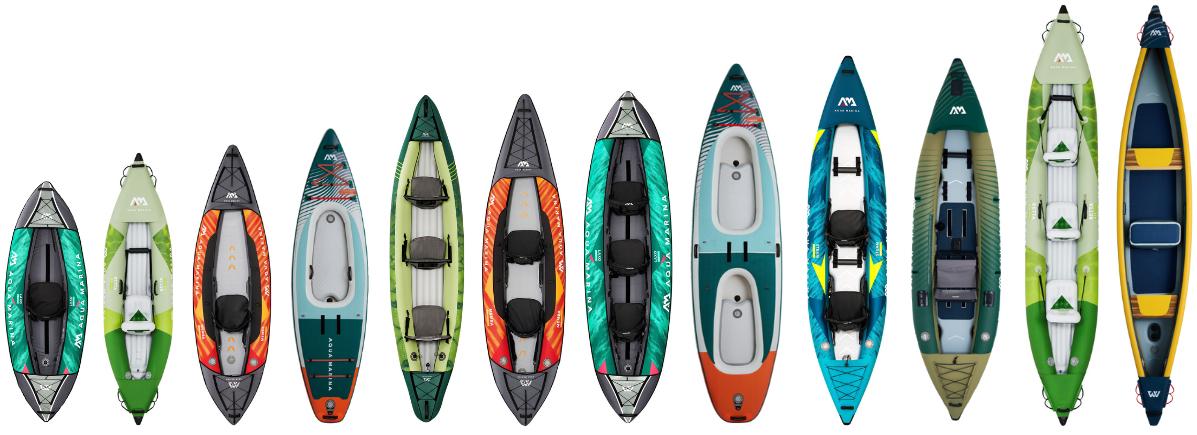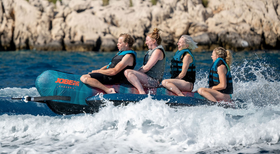
Inflatables: Essential Guide to Choosing the Right Kayak
INFLATABLE KAYAKS have surged in popularity over recent years, offering a practical and affordable option for paddlers of all skill levels. From beginners eager to get started to experienced kayaker looking for a more portable option, inflatable kayaks provide plenty of flexibility and performance.
In this guide, we'll explore everything you need to know about inflatable kayaks, from their construction to their benefits, as well as tips on how to choose the right one for you.

What is an Inflatable Kayak?
As the name suggests, an inflatable kayak is a kayak that can be inflated when in use and deflated for easy storage and transport. They are typically made from durable, high-strength materials like reinforced PVC and are resistant to punctures, abrasions and UV damage. Inflatable kayaks come in a variety of shapes and sizes, suitable for different types of water, ranging from calm lakes to ocean bays and even mild whitewater rivers.
Key Benefits of Inflatable Kayaks
PortabilityOne of the standout features of inflatable kayaks is how easy they are to transport. When deflated, they fold down to the size of a large backpack, which can be stored in the boot of a car, carried onto public transport or even checked in as luggage when flying. This portability makes them perfect for those who want to paddle in a variety of locations without the hassle of a roof rack or trailer.

Traditional kayaks can take up a lot of space in a garage or shed, which isn't ideal if you're limited on storage space. Inflatable kayaks, on the other hand, can be deflated and tucked away in a cupboard or storage shelf, making them an excellent option for people living in flats or homes with minimal storage.
Lightweight
Most inflatable kayaks weigh significantly less than their hard-shell counterparts, which makes them easy to carry to and from the water. This is especially handy if you need to carry the kayak a fair distance from your car to the shore or if you’re heading to a more remote paddling location where you’ll be on foot for a while. Most inflatable kayaks weight between 10-15 kg.
Durability
Although they are inflatable, modern kayaks are built tough. High-quality models use rugged materials such as reinforced PVC, making them resistant to punctures, UV rays and abrasions. Some models even feature multiple air chambers, so if one chamber gets punctured, the others will keep the kayak afloat until you can make it back to shore.
Stability and Comfort
Inflatable kayaks generally have wider bases than hard-shell kayaks, which provides greater stability on the water. This makes them ideal for beginners who might not be as confident with balance. Many inflatable kayaks also come with comfortable, adjustable seats and padded footrests, making them a great option for long paddles and those who prefer a back support.
Versatility
From calm lakes and slow-moving rivers to choppy ocean bays, inflatable kayaks are designed to handle various water conditions. While some models are built specifically for recreational paddling, others are suitable for more adventurous pursuits like fishing, touring or even whitewater kayaking. There are also inflatable kayaks designed for solo paddlers and tandem kayaks for two or more people.
Affordability
Inflatable kayaks tend to be more budget-friendly compared to hard-shell kayaks, making them an excellent entry point for those new to the sport. Even higher-end models that come with additional features or better materials often cost less than comparable hard-shell kayaks. Also look out for bundles. These starter kits usually contain everything you need to hit the water.
How to Choose the Right Inflatable Kayak
With so many options on the market, it’s important to consider a few key factors when choosing the right inflatable kayak for you:
- Intended Use
The first thing to consider is where you’ll be using the kayak. If you plan to paddle on calm lakes and rivers, a recreational inflatable kayak will suit you just fine. If you’re looking for something more rugged to handle ocean surf or mild rapids, you’ll want to choose a model designed for these conditions, which often feature stronger materials and more reinforced hulls.
- Size and Capacity
Inflatable kayaks come in different sizes and seating capacities. If you’re paddling solo, you’ll want a single-seater model, but if you plan to take a friend, partner or child with you, opt for a tandem kayak. Some kayaks, such as those by JOBE, can be converted from single to double.
It’s also important to check the weight capacity to ensure the kayak can comfortably support the paddlers and their accompanying gear.
- Materials
Kayaks, like the Aqua Marina ‘Tomahawk’ series, are constructed entirely from drop-stitch material. Their shape and rigidity are more similar to a canoe than a typical kayak, making them exceptionally fast on the water.
- Air Chambers
- Drop-stitch floor

Drop-stitch technology is a construction method used in high-quality inflatable kayak floors to create a rigid, durable surface. It involves thousands of polyester threads connecting the top and bottom layers of the kayak's inflatable floor. When inflated, these threads tighten, allowing the floor to hold high air pressure, which results in a stiff, solid surface that feels similar to a hard-shell kayak. This provides better stability, performance and durability compared to traditional inflatable designs. Drop-stitch floors are ideal for improving tracking, speed and overall paddling experience.
- Accessories & Combos
If you’re a regular paddler, it is worth investing in a high quality electric pump. There are many on the market to choose from and easily connect to your lighter on the car.
- Ease of Setup
How to Care for Your Inflatable Kayak
To ensure your inflatable kayak lasts for many years, it’s important to take good care of it. Here are some tips for maintaining your kayak:
- Clean it after each use: Rinse the kayak with fresh water after paddling, especially if you’ve been in saltwater. This helps to remove any dirt, sand and salt that can degrade the material over time.
- Dry it thoroughly before storage: Make sure your kayak is completely dry before packing it away to avoid mould and mildew.
- Store it in a cool, dry place: Keep your deflated kayak in a storage bag and store it in a cool, dry place out of direct sunlight to prevent UV damage.
- Inspect for damage regularly: Before each use, check the kayak for any punctures, leaks or wear and tear. Most kayaks come with repair kits, so you can quickly patch any small holes or tears before you set off.

Summary
As this article has shown, modern inflatable kayaks are made from incredibly tough materials and can withstand rough conditions. They often have wider bases, making them more stable and easier to balance than hard-shell ones, especially for beginners. Being lightweight, they are super easy to manoeuvre. Some higher-end models are even designed to be as fast and agile as hard-shell kayaks. And as for transport and storage, nothing is as easy as an inflatable.
Try something new and make up your own mind. See you on the water!


